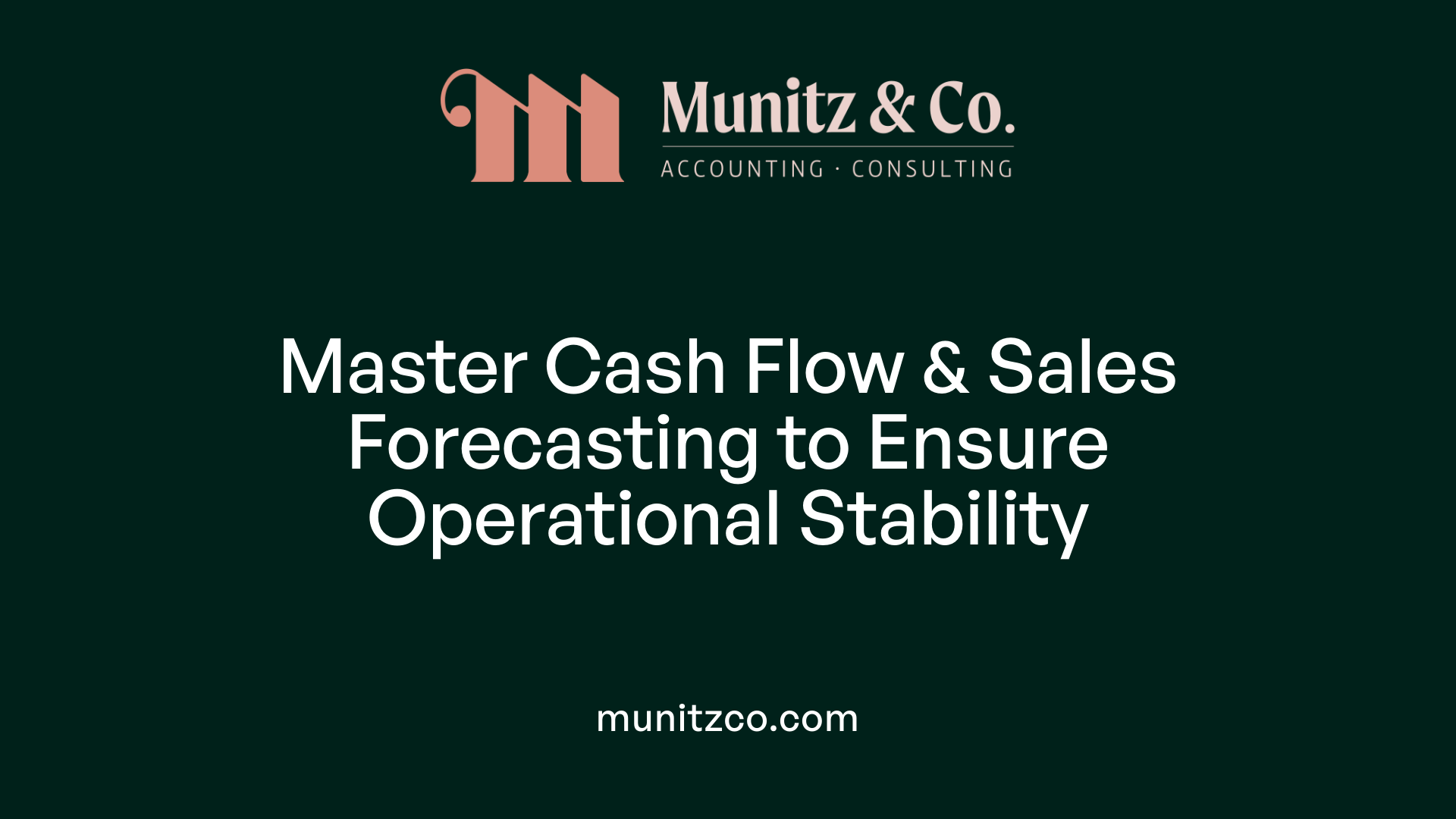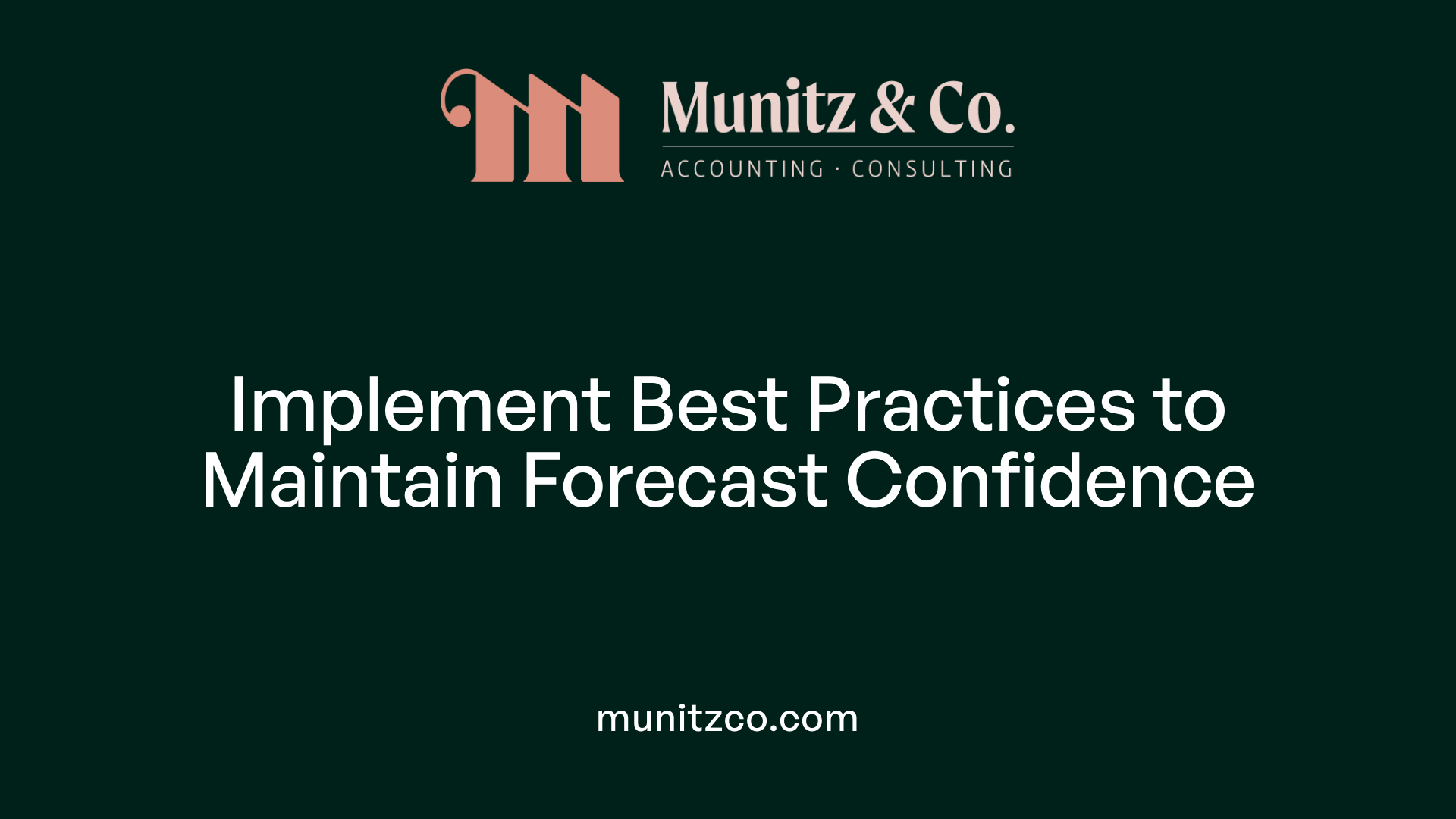The Crucial Role of Forecasting in Uniting Business Functions
In today's fast-paced business landscape, effective forecasting is more than just a financial exercise—it is a critical tool to foster confidence and collaboration across departments. Accurate and dynamic financial forecasting empowers decision-makers, aligns operational activities with strategic goals, and builds investor and stakeholder trust. Yet, many organizations struggle with forecast accuracy and integration, leading to costly mistakes and missed opportunities. This article explores how companies can leverage modern forecasting practices to strengthen cross-departmental trust and drive performance.
The Impact of Forecast Accuracy on Business Confidence and Value
Why Does Forecast Accuracy Matter?
Accurate forecasting is fundamental to how businesses manage their performance. It directly affects how investors view a company and influences its overall business value. When organizations can predict their financial outcomes precisely, it builds trust and confidence among shareholders and stakeholders.
How Does Forecasting Accuracy Affect Business Value and Investor Confidence?
Studies reveal that a mere 22% of organizations are able to produce forecasts within a 5% margin of accuracy. On average, forecast errors deviate by about 13%, which can trigger significant financial repercussions. One striking impact includes an estimated 6% reduction in share prices over a three-year period due solely to forecasting mistakes.
The Statistical Impact on Share Prices
Organizations that maintain forecasting accuracy within 5% of actual results generally enjoy more favorable market outcomes. These companies have experienced share price growth averaging 46%, which notably outperforms the 34% increase seen by less accurate forecasters. This trend highlights the strong correlation between precise forecasting and shareholder returns.
The Cost of Unreliable Forecasts
Unreliable forecasts do not just weaken confidence but also have tangible financial costs. Inaccurate financial projections can lead to misguided strategic decisions, inefficient resource allocation, and missed opportunities, all of which ultimately erode shareholder value.
By prioritizing forecasting accuracy, organizations can strengthen investor confidence, safeguard their market standing, and enhance long-term business value.
Fostering Accountability and Culture Around Accurate Forecasting

How do organizations promote forecast accuracy internally?
Organizations that excel in forecasting understand that accuracy stems not just from data and methods but from a culture that values accountability and transparency. In such organizations, forecasting is treated as a serious discipline rather than a routine task.
Manager Accountability
Managers are held responsible for the accuracy of their forecasts. This means they must own the forecasting process within their areas, ensuring data quality and realistic projections. This accountability encourages greater diligence and ownership.
Incentives for Forecast Accuracy
To motivate precise forecasting, many leading organizations offer incentives aligned with forecast accuracy. Importantly, these incentives focus on relative performance rather than absolute targets to avoid encouraging overly conservative or optimistic projections. By rewarding accuracy, managers are more engaged in refining their forecasts.
Culture of Transparency and Discipline
A culture that prioritizes transparency about forecasting assumptions and results fosters trust and collaboration. Teams openly review forecast deviations and learn from them, promoting continuous improvement. Discipline in adhering to standardized forecasting practices also reduces errors and biases.
Use of Forecasts in Performance Management
Accurate forecasts become integral to performance management systems. They help identify gaps early, allowing for proactive adjustments in strategy and operations. When forecasts drive decision-making and are incorporated into performance reviews, they gain importance and encourage accountability throughout the organization.
By intertwining manager accountability, targeted incentives, a culture of openness, and active use of forecasts in performance management, organizations cultivate a more accurate and reliable forecasting environment.
Leveraging External Data and Scenario Analysis to Improve Forecasts

What external factors enhance forecasting reliability?
Integrating external data greatly boosts the reliability of financial forecasts. Leading organizations gather market reports, competitor insights, and economic indicators to enrich their internal data. However, many companies underutilize these valuable sources, missing opportunities for enhanced foresight.
Key business drivers such as customer demand and prevailing economic trends form the foundation of robust forecasts. By prioritizing these drivers, businesses can better understand market dynamics and align their projections accordingly.
Scenario planning plays a critical role in handling uncertainty and risks in forecasts. This technique allows organizations to consider multiple possible futures by testing different assumptions and market conditions. It enables departments to anticipate challenges and opportunities, fostering more agile and informed decision-making.
Together, the strategic use of external information and scenario analysis helps create a comprehensive picture of potential outcomes. This approach not only improves forecasting accuracy but also strengthens risk management and business resilience in a rapidly changing environment.
Technology’s Dual Role: Challenges and Advances in Forecasting Tools

Limitations of Spreadsheet-Based Forecasting
Many organizations continue to rely heavily on spreadsheets for their financial forecasting. However, this approach is fraught with challenges. Spreadsheets are prone to human error, lack scalability, and often fail to support adequate collaboration among departments. These limitations hinder the ability to produce timely and accurate forecasts, which are critical in today's fast-paced business environment.
Advantages of Advanced Software and ERP Systems
In response to spreadsheet drawbacks, advanced forecasting software and Enterprise Resource Planning (ERP) systems have become increasingly prevalent. These systems automate data integration across various sources, reducing manual input errors. They also provide real-time data updates, which allow organizations to respond quickly to market changes and operational shifts.
Role of AI and Automation in Improving Accuracy and Efficiency
Artificial intelligence (AI) and automation have transformed forecasting by enhancing predictive accuracy and reducing the time required for forecast preparation. AI-driven tools analyze vast datasets rapidly, identify patterns, and provide scenario modeling that supports better decision-making. Automation minimizes repetitive tasks, freeing up financial professionals to focus on interpreting results and strategic planning.
Modern FP&A Software Capabilities
Today's financial planning and analysis (FP&A) software encompasses multiple forecasting methodologies, supports collaborative workflows, and offers seamless scenario testing. These platforms integrate various data streams, from internal financial records to external market indicators, ensuring comprehensive analysis. According to IBM research, forecasts generated using modern FP&A tools are approximately 12% more accurate and require 50% less preparation time compared to traditional methods.
| Technology Aspect | Challenges | Advancements |
|---|---|---|
| Spreadsheet Forecasting | Error-prone, non-scalable, manual | N/A |
| Advanced Software & ERP | Initial implementation cost | Automated data integration, real-time updates |
| AI and Automation | Complexity and skill requirements | Enhanced accuracy, faster processing |
| FP&A Modern Software | Adoption and training | Scenario modeling, collaboration, improved accuracy |
Technology plays a dual role in forecasting—while traditional tools like spreadsheets present significant risks to accuracy and efficiency, advancements in software, AI, and automation offer powerful solutions that modernize forecast processes and drive better business outcomes.
Evolving From Annual Budgets to Dynamic Continuous Planning
Why are organizations shifting from annual budgeting to continuous forecasting?
Traditional annual budgeting has been a mainstay in organizational planning but is increasingly seen as rigid and unable to keep pace with today's fast-changing markets. Budgets set once a year can quickly become outdated, especially in volatile environments where market conditions, customer demands, and economic indicators fluctuate unpredictably.
Limitations of traditional budgeting
Annual budgets often rely on fixed assumptions made at the beginning of the fiscal year, which may no longer hold true as months progress. This rigidity restricts timely responses to emerging challenges or opportunities, leading to missed targets and inefficient resource allocation.
Advantages of rolling and continuous forecasts
In contrast, rolling forecasts and continuous planning processes offer dynamic alternatives. Rolling forecasts, used by over two-thirds of organizations surveyed, involve updating forecasts regularly—often monthly or quarterly—to reflect the latest internal and external information. Continuous planning further integrates forecasting into day-to-day operations, providing real-time visibility into financial and operational metrics.
This approach enhances agility, enabling organizations to adjust strategies, budgets, and resource allocation swiftly based on evolving data. It also supports scenario analysis and what-if planning, helping businesses prepare for multiple potential market outcomes.
Involvement of operational managers
A critical element of successful continuous forecasting is engaging operational managers closely in the process. Their involvement brings deeper insights from frontline operations into forecasting models, making projections more accurate and actionable. This collaboration fosters accountability and a culture that values forecast accuracy.
Adaptability to market changes
Dynamic forecasting approaches are better suited to handle external uncertainties such as market competition, economic shifts, and customer demand variability. By integrating these factors regularly, organizations increase forecast reliability, support more informed decision-making, and improve investor confidence.
Overall, transitioning from static annual budgets to rolling, continuous forecasts empowers organizations to stay aligned with business realities and seize opportunities in a rapidly evolving landscape.
Quantitative and Qualitative Forecasting Methods: Balancing Data and Expertise
What forecasting methods build accuracy and confidence across teams?
Forecasting accuracy and confidence stem from blending quantitative and qualitative methods effectively. Quantitative techniques rely on historical numerical data and statistical models to predict future outcomes. Common quantitative methods include regression analysis, moving averages, and Monte Carlo simulations. These enable organizations to identify patterns and trends in data-rich environments, offering objective and measurable forecast results.
Conversely, qualitative approaches leverage expert judgment and market insights rather than purely historical data. Techniques such as the Delphi method, which gathers consensus opinions from experts, and market research, which analyzes consumer behavior and industry trends, are valuable when historical data is limited or when launching new ventures.
When to use each method
Quantitative forecasting excels when there is ample, reliable historical data, enabling statistical models to produce precise and replicable results. This suits mature businesses with consistent financial records and predictable market conditions. Qualitative methods become essential when entering new markets, developing innovative products, or facing rapidly changing external environments where data scarcity or uncertainty prevails.
Integration of methods for robust forecasting
The most effective forecasting practices integrate both approaches, combining quantitative data analysis with qualitative insights. This balance allows organizations to ground predictions in solid data while incorporating expert intuition and market dynamics. For example, applying regression models can forecast sales volumes, while expert panels may adjust these figures based on upcoming regulatory changes or competitor behavior.
Common quantitative forecasting techniques
- Regression Analysis: Models relationships between variables to forecast outcomes.
- Moving Averages: Smooths out data fluctuations for short-term trend prediction.
- Monte Carlo Simulations: Uses probability distributions to simulate various scenarios.
Examples of qualitative forecasting methods
- Delphi Method: Engages experts in iterative surveys to reach consensus.
- Market Research: Analyzes consumer preferences, trends, and competitor activity.
- Expert Panels: Collects subjective insights to complement data-driven forecasts.
Utilizing this combined approach fosters greater forecast reliability, increases stakeholder confidence, and enhances strategic decision-making across teams.
Cross-Department Collaboration: The Key to Holistic Forecasting
How does cross-department collaboration improve forecasting?
Cross-department collaboration brings together operational and financial teams, creating a comprehensive perspective that significantly enhances forecasting accuracy. By sharing data and insights, teams can identify potential risks earlier and spot emerging opportunities that might otherwise be overlooked.
When production, sales, and finance goals are aligned, the forecasting process supports cohesive organizational strategies. This synergy fosters shared accountability, ensuring that everyone is working towards common targets rather than isolated objectives.
Involving operational managers in forecasting introduces real-time, ground-level insights that complement the financial data. This combined approach strengthens the reliability of forecasts and improves decision-making.
Ultimately, collaboration across departments builds trust and transparency. It encourages regular communication and continuous refinement of forecasts, crucial for adapting swiftly in today’s fast-changing business environments. Organizations that embrace this integrated approach are more likely to develop agile, accurate financial forecasts that drive better resource allocation and strategic planning.
The Role and Benefits of Outsourced CFOs in Enhancing Forecasting
How do outsourced CFOs contribute to better financial forecasting?
Outsourced CFOs offer specialized expertise and an objective financial analysis that many organizations lack internally. Their experience allows for the development of customized forecasting models tailored to specific business needs and industries. This expertise is crucial for managing cash flow effectively, assessing financial risks, and ensuring that forecasts align tightly with strategic company goals.
Advanced Technology Usage
Leveraging advanced software, automation tools, and data analytics, outsourced CFOs enhance forecast reliability. Unlike organizations that rely primarily on spreadsheets, these professionals utilize cutting-edge forecasting tools and ERP systems to deliver more accurate, real-time insights. This technology adoption supports continuous updates and scenario-based planning.
Cost-Effectiveness and Risk Assessment
Hiring an outsourced CFO provides a cost-effective alternative to full-time senior financial leadership. They offer strategic financial management and forecasting services without the fixed overhead, making it an efficient option for many businesses. Their objective approach helps identify and mitigate forecast risks, such as data quality issues and external market influences, improving overall forecast accuracy and reducing costs related to forecasting errors.
Case Studies Demonstrating Forecasting Improvements
Several case examples show how organizations have benefited from partnering with outsourced CFOs. These partnerships have led to enhanced prediction accuracy, better strategic decision-making, and stronger investor confidence. Businesses have reported improved share price performance and financial outcomes as a direct result of more reliable and actionable forecasts crafted with outsourced CFO guidance.
Cash Flow and Sales Forecasting: Cornerstones of Operational Confidence

Why are cash flow and sales forecasting critical for operational departments?
Cash flow forecasting plays a crucial role in ensuring that a business can meet its financial obligations without interruption. By predicting when cash shortages or surpluses might occur, organizations can plan accordingly to maintain liquidity. However, this remains a significant challenge—about 80% of small businesses experience struggles with managing cash flow effectively.
Sales forecasting is equally essential as it estimates future revenues through analyzing historical sales data and current market trends. This forecasting informs vital business decisions, allowing firms to allocate resources efficiently and craft effective marketing strategies tailored to anticipated demand.
Methods and Benefits of Sales Forecasting
Sales forecasting employs various techniques including trend analysis, regression models, and scenario planning. These methods empower businesses to foresee potential shifts in the market and adjust accordingly. Enhanced forecast accuracy supports better inventory management, staff scheduling, and customer service.
In professional services industries, where revenue can be irregular and project-based, forecasting models are customized to account for project variability. This specialized approach helps service firms plan budgets, manage cash flow, and mitigate risks more confidently.
Common Challenges and Strategic Responses
Many small and service-oriented firms face obstacles such as inconsistent revenue streams and limited forecasting expertise. Overcoming these challenges involves adopting tailored forecasting tools, integrating external market data, and fostering collaboration across departments to enhance data quality.
To sum up, cash flow and sales forecasting are foundational in supporting operational confidence. They enable organizations to anticipate financial needs, allocate resources effectively, and align strategies with market realities, helping to ensure sustainability and growth.
Integrating Forecasting Methods With Strategic Planning and Risk Management
How does forecasting support strategic planning and risk management?
Financial forecasting plays a crucial role in bridging data and strategic decisions. By translating complex financial data into actionable insights, organizations can evaluate various 'what-if' scenarios to anticipate future circumstances and adjust plans accordingly.
Alignment with long-term business goals
Forecasting aligns financial projections tightly with an organization's long-term objectives. This connection ensures resource allocation and investment decisions drive meaningful growth initiatives. Whether it’s supporting growth over one to five years or preparing for new market entrants, forecasts provide a roadmap aligned with strategic ambitions.
Use of 'what-if' and scenario analysis
Scenario analysis is essential for handling uncertainty within forecasting. By exploring different potential futures based on varying assumptions—such as economic shifts or demand changes—organizations can prepare flexible strategies and adjust quickly to real-world conditions.
Risk assessment and mitigation planning
Forecasting supports proactive risk management by identifying financial vulnerabilities before they manifest. Cash flow forecasting highlights potential shortages or surpluses, while scenario planning helps mitigate risks by enabling contingency approaches that protect profitability and stability.
Stakeholder engagement through transparent forecasting
Transparent forecasting fosters stakeholder confidence by clarifying assumptions, methodologies, and expectations throughout the organization. Engaging operational managers and finance leaders collaboratively enhances forecast accuracy and nurtures trust, enabling better-informed decisions and stronger investor relations.
By integrating accurate forecasting with strategic planning and risk management, organizations can optimize resources, improve agility, and ensure sustainability in uncertain business environments.
Improving Forecast Precision Through Modern FP&A Software and Automation
Automation of Data Collection and Integration
Modern FP&A (Financial Planning and Analysis) software automates the process of collecting and integrating vast amounts of financial and operational data. This automation not only saves time but also minimizes the risk of errors that are common in manual data entry, especially when relying on spreadsheets. By consolidating data from various sources seamlessly, organizations prepare a more reliable foundation for forecasting.
Scenario Modeling and Real-Time Updates
A standout feature of advanced FP&A tools is their capability to perform scenario modeling. This allows businesses to simulate different financial outcomes based on varying assumptions and external factors. Coupled with real-time updates, forecasts become more dynamic and can adjust quickly to market changes or operational shifts. This flexibility supports better decision-making under uncertainty.
Reduction of Manual Errors
Manual processes in forecasting are prone to mistakes, which can drastically affect forecast accuracy. Automation offered by modern FP&A solutions reduces these errors significantly. This enhancement leads to forecasts that are not only more precise but also more reproducible and consistent over time.
Collaboration Features Enhancing Departmental Alignment
FP&A platforms include collaboration tools that foster communication and transparency among different departments. By enabling operational, financial, and strategic teams to share insights and data openly, these tools help ensure that forecasts reflect a holistic understanding of the organization’s realities and strategies.
Answer to Question: What Advantages Do Modern FP&A Tools Offer for Forecasting?
Modern FP&A software offers a range of advantages including the automation of data collection and integration, support for scenario modeling, and provision of real-time data updates. These features reduce manual errors and speed up the forecasting process. Additionally, collaborative interfaces promote cross-department sharing, which enhances transparency and alignment. Research by IBM highlights that such tools can improve forecasting accuracy by 12% and halve the time required to prepare forecasts, making them indispensable in improving forecast reliability and business agility.
Best Practices and Common Pitfalls in Forecasting to Sustain Confidence

What practices help maintain effective forecasting, and what pitfalls should be avoided?
Maintaining effective forecasting requires a disciplined approach that focuses on regular updates and thorough validation. Utilizing rolling forecasts—updated frequently—helps organizations adapt to new data and market conditions swiftly, thereby enhancing forecast reliability. Starting with simple forecasting models that are easier to validate and understand is crucial; complexity should be introduced gradually as confidence and data quality improve.
Incorporating external factors such as market reports, competitor data, and economic indicators enriches forecast accuracy by providing a broader context beyond internal historical data. Active involvement of cross-functional teams, especially operational managers, leads to more practical and accountable forecasts.
However, common pitfalls can seriously undermine the forecasting process. Overreliance on qualitative data—such as expert opinion without quantitative backing—may skew results, especially when unsupported by solid data. Similarly, ignoring external factors limits the forecast's relevance in today’s rapidly changing markets. Failing to update forecasts regularly, particularly in volatile industries, risks outdated assumptions causing poor decision-making. Such pitfalls erode investor confidence and can result in costly misallocations of resources.
By fostering a culture that values transparency, accountability, and continuous refinement, organizations can improve forecast accuracy and sustain stakeholder trust over time. Combining disciplined processes with strategic use of both qualitative and quantitative inputs is essential for robust, reliable financial forecasts.
Building a Culture of Confidence Through Forecasting Excellence
Forecasting that builds confidence across departments is foundational to a company’s financial and operational success. By embracing accuracy, accountability, collaboration, and technology, organizations can transform forecasting into a powerful enabler of trust and strategic alignment. Adopting integrated, dynamic forecasting methods and leveraging expert resources such as outsourced CFOs drive better decision-making, risk management, and investor confidence. Ultimately, embedding forecasting as a disciplined organizational capability fosters transparency and shared ownership, empowering all departments to contribute to sustainable business growth.
References
- Forecasting with confidence - KPMG agentic corporate services
- Financial Forecasting: A Guide from an Outsourced CFO
- Comprehensive Guide To Financial Forecasting - Pigment
- 7 Financial Forecasting Methods to Predict Business ...
- How to Create a Financial Forecast in 8 Strategic Steps
- Why financial forecasting can be your business's best defense
- Discover Financial Forecasting Methods for Accurate ...
- Revenue Forecasting in Finance: What Is It, How to Do ...
- FP&A Tips & Strategies: Revenue Forecasting Methods







